Virgo Cluster spiral
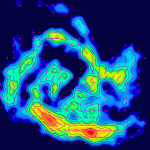
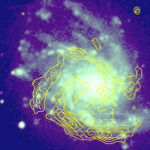 NGC 4254 was for a long time a puzzling case: it possesses a bright ridge of
polarized emission (indicating highly ordered magnetic fields) outside of a
southern spiral arm (against the density wave theory). This ridge appears to be
the brightest polarized feature in this galaxy. The pictures show the contours
and B-vectors of polarized intensity of the brightest polarized emission
superimposed upon the Digital Sky Survey image (an RGB combination of blue and
red), as well as, a combination of colour scale, contours and B-vectors of the
same quantity. The pictures were made using VLA at 3.6 cm
(Chyży et al. 2007).
NGC 4254 was for a long time a puzzling case: it possesses a bright ridge of
polarized emission (indicating highly ordered magnetic fields) outside of a
southern spiral arm (against the density wave theory). This ridge appears to be
the brightest polarized feature in this galaxy. The pictures show the contours
and B-vectors of polarized intensity of the brightest polarized emission
superimposed upon the Digital Sky Survey image (an RGB combination of blue and
red), as well as, a combination of colour scale, contours and B-vectors of the
same quantity. The pictures were made using VLA at 3.6 cm
(Chyży et al. 2007).
 The effects of an external compression were apparently supported by the
"phase diagram" for NGC 4254 (the left panel). The compression by an ambient gas was
our initial suggestion (Soida et al. 1996).
The effects of an external compression were apparently supported by the
"phase diagram" for NGC 4254 (the left panel). The compression by an ambient gas was
our initial suggestion (Soida et al. 1996).
However, recent studies by (Chyzy et al 2008) suggest it to be rather the result of tidal interaction with the "dark galaxy" discovered by Minchin et al. (2007)
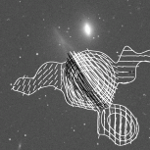
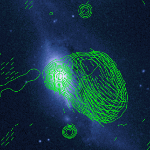 NGC 4438 is an example of the galaxy undergoing a combined effect of
ram-pressure stripping (it is only 1° from the Virgo Cluster core) and of
tidal interactions. In addition to its active nucleus, it exhibits a complete
displacement of its total power and polarized emission from the disk (left
Figure, Vollmer, Soida et al
2007). This picture has
been made using VLA at 6cm.
NGC 4438 is an example of the galaxy undergoing a combined effect of
ram-pressure stripping (it is only 1° from the Virgo Cluster core) and of
tidal interactions. In addition to its active nucleus, it exhibits a complete
displacement of its total power and polarized emission from the disk (left
Figure, Vollmer, Soida et al
2007). This picture has
been made using VLA at 6cm.
The Effelsberg 6cm polarization data (right panel, Wezgowiec et al. 2007) show two vertical magnetized streams extending beyond 10 kpc from the disk and containing vertical magnetic fields.
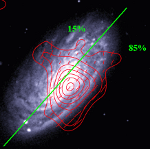 NGC 4501 in a Virgo Cluster heavily stripped by the intracluster gas. Our
Effelsberg polarization observations at 2.8 cm show a striking asymmetry in
polarized brightness (thus in the distribution of the regular magnetic field,
Wezgowiec et al. 2007).
In fact 85% of the polarized flux comes from the SW side of the major axis
(marked as a green line).
NGC 4501 in a Virgo Cluster heavily stripped by the intracluster gas. Our
Effelsberg polarization observations at 2.8 cm show a striking asymmetry in
polarized brightness (thus in the distribution of the regular magnetic field,
Wezgowiec et al. 2007).
In fact 85% of the polarized flux comes from the SW side of the major axis
(marked as a green line).
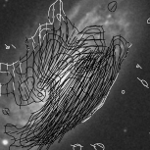
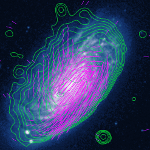 A detailed study of NGC 4501 using VLA at 6cm
(Vollmer, Soida et al 2007)
fully confirmed the Effelsberg results, showing:
A detailed study of NGC 4501 using VLA at 6cm
(Vollmer, Soida et al 2007)
fully confirmed the Effelsberg results, showing:
- a steep gradient of total power emission along the SW disk edge,
- the bulk of polarization coming from a relatively narrow ridge along the SW disk,
- considerably larger magnetic pitch angle in NE than in the SW disk portion.
The polarization properties of this galaxy have been successfully modeled by Vollmer, Soida et al. (2008). These Authors claim this galaxy to be in a pre-peak stripping phase.
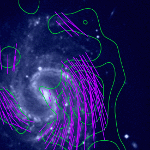
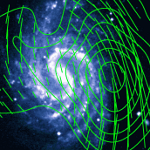 This is NGC 4535, the galaxy showing the radio polarization asymmetry without
any counterpart in other domains. The galaxy is pretty symmetric in the optical
and HI domains (see the underlying DSS blue images). It is situated in the
Southern Virgo Extension, not too rich in the hot IGM, able to generate such an
asymmetry. Is this a "magnetic memory" of past interactions? The asymmetry at 6
cm (right panel) is even greater than at 3.6 cm (left panel). Observations were
made using the 100-m Effelsberg radio telescope. See
Wezgowiec et al. 2007
for details.
This is NGC 4535, the galaxy showing the radio polarization asymmetry without
any counterpart in other domains. The galaxy is pretty symmetric in the optical
and HI domains (see the underlying DSS blue images). It is situated in the
Southern Virgo Extension, not too rich in the hot IGM, able to generate such an
asymmetry. Is this a "magnetic memory" of past interactions? The asymmetry at 6
cm (right panel) is even greater than at 3.6 cm (left panel). Observations were
made using the 100-m Effelsberg radio telescope. See
Wezgowiec et al. 2007
for details.
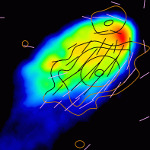 This is an example of a mixture of ram-pressure stripping and tidal
interactions. The galaxy NGC 4654 interacts with both IGM and its neighbour
(beyong the top right corner of the image. Pictured here is the HI image of NGC
4654 (colours) from Phookun & Mundy 1995.
Overlaid are the contours of polarized intensity and B-vectors from our
Effelsberg observations at 3.6 cm. Note the polarization peak at the base of
the HI tail.
This is an example of a mixture of ram-pressure stripping and tidal
interactions. The galaxy NGC 4654 interacts with both IGM and its neighbour
(beyong the top right corner of the image. Pictured here is the HI image of NGC
4654 (colours) from Phookun & Mundy 1995.
Overlaid are the contours of polarized intensity and B-vectors from our
Effelsberg observations at 3.6 cm. Note the polarization peak at the base of
the HI tail.
